Cymoscope or Chips? Peculiar terms
to describe a device for handling electromagnetic radiation.
While the latter is well known nowadays, Cymoscopes - (from
the Greek: cyma = waves; scope = see), was not so familiar to
the pioneers of radio science. Therefore, in spite of early
strange terms or even theories, the scientific understanding
of semiconductor materials started by the end of XIX century,
when several scientists studied the photovoltaic rectifying
effects in chemical compounds and elements like metallic sulphides
and Selinium.
In 1874, the German physicist Karl Ferdinand Braun, discovered
that certain minerals such as, galena, lead sulphide had the
property of unidirectioned conductivity, i.e. allow the passage
of A.C. electrical impulses in one direction but inhibit their
return surge.
In reality Braun's studies established the rectifying properties
of the contact of a metal wire on the surface of mineral galena,
creating thus the first metal-semiconducting junction. Fig 243
Based on the research work of Prof. Braun, in 1902 Greenleaf
Whittier Pickard discovered the principle of crystal detection.
It is indeed very simple as it behaves as a rectifyer, converting
high frequency radiation from alternating current to direct
current.
Pickard's crystal detector, known as cat's whisker, was manufactured
since 1906, when another experimenter, H.H.C. Dundwoody, used
this type of detector in a practical way. Fig 244
General Dundwoody while working for the U.S. Army also invented
the carborundum radio detector in 1906.
The crystal detector was an innovation in detecting electromagnetic
radiation due to its sensitivity as well as practicity. Fig
245
However, considering that it could not amplify signals, its
decline began with the development of more reliable termionic
devices such as the Fleming diode in 1904, and finally the triode
valve invented by Lee de Forest in 1906. |
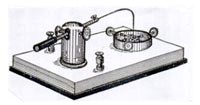 |
| Fig-243 - Principle of metal-semiconducting
junction |
|
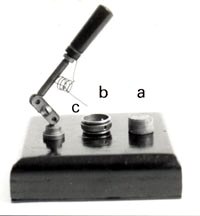 |
Fig. 244 - Illustration of Pickard's
crystal detector, known as cat's whisker, where:
a) Mineral detector
b) Holder for the mineral detector
c) Metallic contact |
|
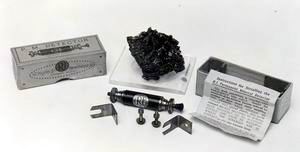 |
| Fig. 245 - Illustration of a complete
permanent mineral detector, manufactured in England
showing its hardware for installing, instruction manual
and the cardboard box. A piece of carborundum, the mineral
used in the detector construction is seen in the center.
General H.H.C. Dundwoody invented the carborundum radio
detector in 1906. |
|
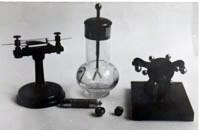 |
Sstudent wireless experiment kit circa
1900, comprising:
- Coherer holder
- Gold leaf electroscope
-Spark gap device
-Carborundum detector and fittings |
|
 |
Fig. 244a - Several types of mineral
detectors:
a) and c) differentes types of Galena, Lead Sulphide
c) Commercial type of crystal detector sold under the
tradename "Cymosite" |
|
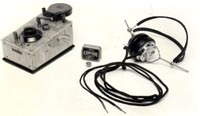 |
| Fig 246 - a typical vintage crystal
radio set showing: the crystal set provided with the
cat's whisker and the crystal holder, the crystal detector
"Cymosite" and the earphone. |
|
|